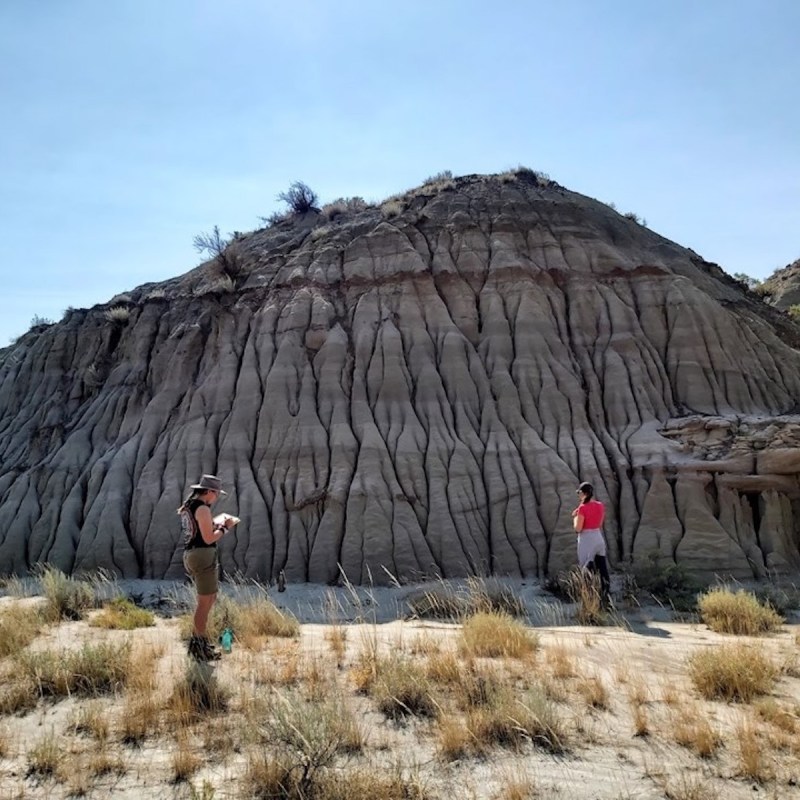
It’s one thing for scientists to discover dinosaur fossils, but a “dinosaur mummy” with fossilized skin is something else altogether. In fact, finding a dinosaur skeleton with fossilized skin textured like a basketball is probably a once-in-a-lifetime discovery.
Videos by TravelAwaits
Indeed, when he first saw a newly discovered specimen in Canada, Dr. Brian Pickles, a paleontologist and ecology professor from the University of Reading in the United Kingdom, said he “was completely blown away,” according to Live Science. “I’ve never seen anything like it.”
In 2021, the fossil of the hadrosaur — a large, plant-eating, duck-billed dinosaur — was found protruding from the side of a hill in Dinosaur Provincial Park in southern Alberta, Canada, according to the University of Reading. The area is known as one of the world’s “richest locations for dinosaur fossils,” the university notes.
The fossil was first discovered by Teri Kaskie, an environmental specialist who volunteers to help Pickles and his colleagues run an international paleontology field school. They strive to teach students from the University of Reading and the University of New England in Australia about field techniques in Alberta. Pickles was leading a search of the area when Kaskie saw the dinosaur foot and part of a tail with fossilized skin.
Now the team has returned to the area to collaborate with the Royal Tyrrell Museum in Canada to excavate the skeleton while simultaneously protecting the exposed fossil.
“It’s hard to imagine,” Pickles said. “This animal died 76 million years ago. It’s been perfectly preserved since then and it just happened to be just starting to erode out of this cliff when we were walking by.”
The dinosaur has been preserved so well that the paleontologists can see its tendons and its “scaly skin has a basketball-like texture.” Pickles suspects it either died and was soon covered by sand and silt in the river, or that the dinosaur died when the riverbank eroded and fell on it.
“This is something really special; you don’t find things like this very often out in the field,” Pickles said, according to Live Science.

Why The Find Is Significant
Hadrosaurs, which lived 75 to 65 million years ago, are known as duck-billed dinosaurs because they had a “flattened and beak-tipped snout” that allowed them to easily snap off leaves and twigs to eat, according to Fossilera. Interestingly, they also had hundreds of teeth that ground the vegetation before the dinosaur swallowed it.
“Based on the small size of the tail and foot, this is likely to have been a juvenile,” Pickles notes, according to the University of Reading. “Although adult duck-billed dinosaurs are well represented in the fossil record, younger animals are far less common. This means the find could help paleontologists understand how hadrosaurs grew and developed.”
While adult hadrosaurs were about 32 feet long, Pickles estimates this juvenile was about 13 feet long.
What Happens Next
Collection of the entire skeleton may take several months, and even multiple field seasons. Then, once a block containing the skeleton is removed from the hillside, it will be transported to the Royal Tyrrell Museum’s Preparation Lab for technicians to further uncover the fossil.
During the preparation process, the technicians will determine how well-preserved the skeleton is, whether the entire skeleton has been collected, and how much of the animal’s skin is preserved. Importantly, the exact species of the duck-billed dinosaur is currently unknown, and will only be possible to determine if its skull is discovered as well.
Fully preparing the skeleton for research and eventual display at the Royal Tyrrell dinosaur museum display may take several years.
For more about dinosaurs in Canada, be sure to also read about the 6 Best Places To Experience Dinosaurs In Canada.
And for recent news about dinosaur fossils, be sure to read:
